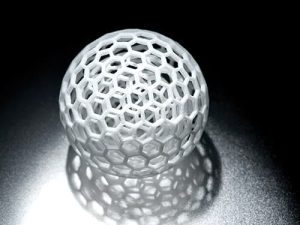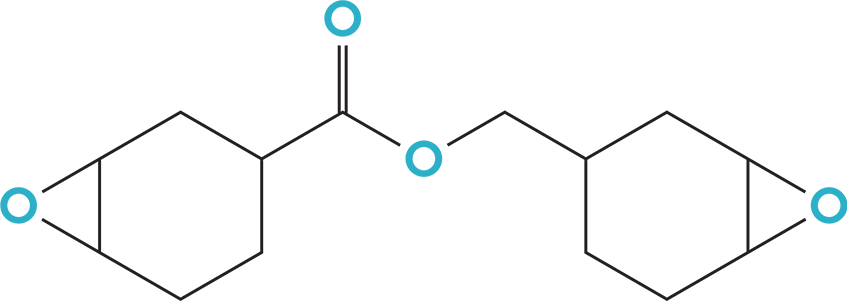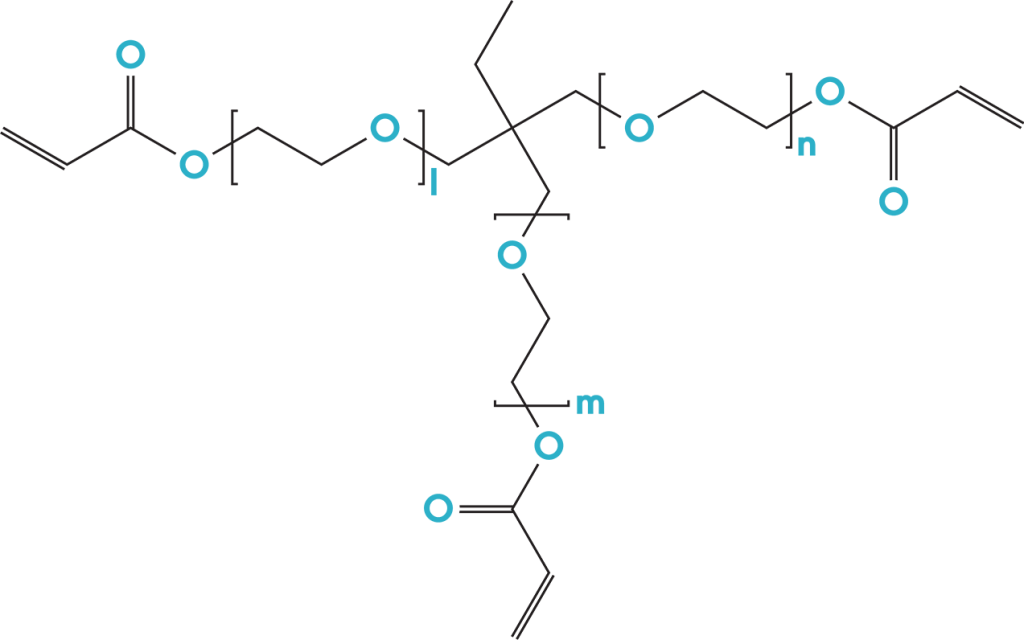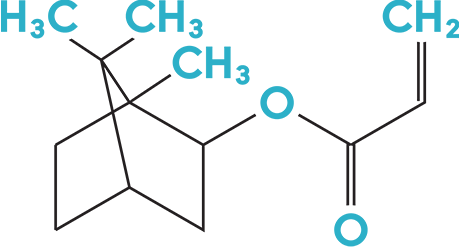EnduraSol™ materials are custom surface-modified nanosilica particles dispersed in commonly used epoxy or acrylate monomers. Other reactive carrier systems are in development and available upon request.
The ability to create high performance 3D printed parts and UV cure coatings using these materials is based on two main principles, the manufacture of the particles themselves, and the steps taken later to modify them to make them compatible in the print and coating systems.
Manufacture of EnduraSol™ (silica-nanocomposite) Monomer Sols
Composite monomer resins can be manufactured from silica nanoparticles and organic monomers or resins using a complex, multi-stage process. The first stage of production is the water glass process, where produced spherical silica nanoparticles of 5-80 nm diameter can be grown in an aqueous environment. More stages follow the water glass process, in which the water is ultimately replaced by the monomer or resin of choice to yield the final material.
EnduraSol™ Materials produced in this way contain, depending on the monomer or resin, up to 50% of surface-treated silica in nano-particulate form and are stable for at least six up to eighteen months. These products can be crystal clear, completely transparent and show no sedimentation. Free silica-nanoparticles cannot be prepared in this way, as they have a tendency to form micron-sized agglomerates which cannot be re-dispersed. This would lead to the loss of all the desirable properties of the silica-nanocomposites, such as transparency and scratch and abrasion resistance.
The field of applications for monomer sols is quite broad. Two promising application areas include photo-polymer 3D printing and UV curable coatings. The benefits of using the EnduraSol™ Materials in these applications are discussed below.
3D Printing
The nature of these reactive nano-silica composite systems makes them ideal components in 3D print formulations for technologies like stereo-lithography, DLP and material jetting. When correctly formulated in print compositions, the proprietary surface modified nano-silica particles used in EnduraSol™ materials help produce parts with extremely high tensile strength and modulus values. They are also engineered for excellent stability in organic systems, which is critical for consistent print quality.
Additional Benefits
Listed below are some key performance advantages sought in a 3DP resin or printed part. The improvement in each advantage can in some way be linked to the properties of the nano-silica monomer sol as follows:
- Reduced shrinkage resulting in improved edge sharpness and very high print accuracy – Many filler types are larger micron sized materials with non-uniform shapes. The uniform shape and tight size distribution of EnduraSol™ Materials ensure performance variation is minimized from lot to lot of material and corresponding final product. These particles are also the reason why print users see significantly improved print accuracy in a 3D printed part.
- Superior abrasion resistance – Being an intrinsic part of the 3D printed matrix, the silica particles offer uniform resistance to deformation at both the surface and underlying layers. This property greatly improves the ability of the part to withstand the rigor of an abrasive force from any direction being applied to the part.
- High heat deflection temperature – The low thermal conductivity of the silica particles, coupled with low thermal expansion coefficient (see below), increases both the heat resistance and dimensional stability of the 3D printed part.
- Low coefficient of thermal expansion (CTE) – The introduction of inorganic components in amounts related to that of the shrinkable organic resins leads to smaller temperature related effects at the same part size.
- Low viscosity (for faster application, smoother surface, improved print accuracy) – Unlike their fumed silica counterparts, surface treated nano-silica can be easily incorporated into resin systems without a significant viscosity increase. The surface treatment provides the necessary steric separation layer on each particle that limits the polar boding effect from causing associative thickening in the liquid resin.
- Viscosity stability – The surface treated nano-silica particles are designed to have optimal compatibility with the surrounding monomer and other formulation components of like polarity. As such, they will not coalesce over extended storage times whilst in liquid form prior to application. This then improves long-term storage and long-term application/print behavior. The silica based nanoparticle composites will not form agglomerates or sediments, like either fumed silicas or larger micro-particles respectively.
Coatings
EnduraSol™ Materials can be used in coatings to improve performance to levels that cannot be produced by conventional means or that can only be achieved by multiple coats. Coating applications include systems where high scratch and abrasion/chemical resistance is needed at the same time as transparency.
The silica nanoparticles within the EnduraSol™ Line are used in organic matrices in coating materials. Their inherent properties enhance the performance of coating films in the following ways:
- Improved scratch and abrasion resistance – Most coating additives only impart this desired performance at the surface of a coating film. The nano-silica, once incorporated, offers uniform resistance to deformation at both the surface and underlying layers. This property greatly improves the ability of the part to withstand the rigor of an abrasive force from any direction. A typical recommendation is to have the nano-silica present at 5 to 10% w/w relative to the solids of the paint formulation to enhance these properties.
- Improved barrier properties – The increase in barrier properties to transmission of gases, liquids and other physical phenomena is the result of several mechanisms that are enhanced by the presence of silica nano-particles. The addition of silica nanoparticles also generates a barrier effect in the cured film against solvents and can increase resistance by up to 400%. In the cured, filled coating, the nanoparticles can position themselves in the gaps between the filler and the pigment permitting, on the one hand, a marked increase in the absolute filler content (of particular interest for high solids coatings) and, on the other, denser packing of all inorganic components. Silica nanoparticles are also suitable for applications where a barrier effect is required especially where transparency is also essential. Diffusion of oxygen and water vapor is thus significantly lower than in an unmodified clear coat.
- Improve total transparency of the coating – The combination of mono-dispersed, hydrophobic, relatively anti-reflective particles in the film provides the mechanism of improved light transmission through a transparent coating film. The fact that the filler itself is inorganic in nature, and less likely to change in character over time, means the films are also more durable than their non-filled counterparts.
- Control of coating gloss – The degree of gloss of the formulation is not affected by the silica nanoparticles. Unlike surface waxes or other silicas, which are added as matting agents, the nanoparticles do not settle out on the surface but are, distributed evenly throughout the entire film. Increased hardness, scratch and abrasion resistance can thus be achieved in coatings of all levels of gloss.
- Reduced shrinkage during curing – The correct choice of low-shrinkage binders, coupled with the addition of nano-silica on the other is crucial for successful formulation of clear coats.
- Reduced tension stress during curing – The introduction of inorganic (silica) components in amounts related to that of the shrinkable organic resins leads to smaller stress induced defects at the same film thickness. The nanoparticles act as modulating sites to evenly distribute stresses induced during the curing process. Defects like bending or curling which can occur with foils or other thin coating film applications can be significantly reduced by the incorporation of silica nanoparticles.
- Reduced settling – In filler formulations containing microscale fillers or pigments, the nanoparticles can reduce settling of the fillers. This can be attributed to the loosening effect of the nanoparticles which position themselves between the micro-particles and prevent close particle packing.
- Improve adhesion on substrates – The improvement in barrier properties, imparted by the nano-particles, also increases the hydrophobicity at the coating/substrate interface leading to higher adhesion and increased corrosion resistance as a side benefit.
- Reduced viscosity – The reason for this low increase in viscosity lies in the monodispersed silica nanoparticles which, with their special surface modification, show different behavior than milled silicon dioxide or fumed silica. Use of these latter materials give rise to an almost exponential increase in viscosity at higher amounts which, at these levels, would lead to a solid mass. Use of silica-nanocomposites is much easier in practice. The products can be thoroughly stirred together with the main binder at the start of the production process. As a result of the special surface modification of the nano-silica particles, the silica nanocomposites only produce a relatively small increase in viscosity. In general, incorporation of 50% w/w nano-silica leads to a viscosity only 4-5 times higher than with the original resin.
EnduraSol™ • Nanosilica Particle Monomer Dispersions
Epoxy
| Grade | Carrier | Average Particle Size, nm (BET) | Particle Shape | Silica Content |
|---|---|---|---|---|
| EPC 7540 | Cycloaliphatic Epoxy Resin | 75 | Spherical | 40% |
| OXA 7540 | OXA | 75 | Spherical | 40% |
Acrylate
| Grade | Carrier | Average Particle Size, nm (BET) | Particle Shape | Silica Content |
|---|---|---|---|---|
| TCDDA 1250 | TCDDA | 12 | Spherical | 50% |
| EOTMPTA 1250 | EOTMPTA | 12 | Spherical | 50% |
| EOPETA 1250 | EOPETA | 12 | Spherical | 50% |
| IBOA 1250 | IBOA | 12 | Spherical | 50% |
EnduraHSP™ • Hydrophobic Silica Powder
| Grade | Carrier | Average Particle Size, nm (BET) | Particle Shape | Silica Content |
|---|---|---|---|---|
| EnduraHSP™ 45 | – | 45 | Spherical | 100% |






